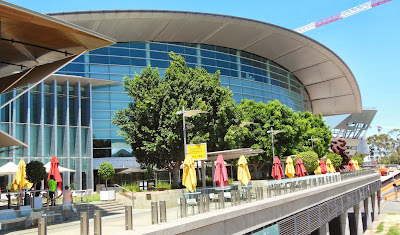There’s a reason they call it Kangaroo Island.
The island is so named because Captain Matthew Flinders was the first Brit to explore the south coast of Australia. His crew set ashore and slaughtered 31 kangaroos…the first fresh meat they’d had in 4 months. Thus the name.
(As a consequence of his explorations, every city or town on Australia’s south coast has a street or square named after him)
On December 24th, we took the ferry from Cape Jervis for three days on Kangaroo Island.
The island is a remarkable place. It’s 96 miles long and 30 miles wide...10 times the size of Whidbey Island.
 |
| Duck Lagoon |
Its 15 national parks and conservation areas make it largely wilderness, an ideal place to see wildlife.
 |
| Flinders Reach National Park |
There are large stretches of eucalyptus forests.
 |
Cape Du Couedic
|
Pounding surf ...
 |
| Admiral's Arch |
...incredible rock formations...
 |
| The view from our B&B |
...and beautiful sunsets.
There are loads of birds.
 |
| Black Swans |
 |
| The pelicans were pretty tame |
 |
| Flinders Reach National Park |

Birds, we had no trouble finding. Kangaroos and Koalas were another matter. In 11 days of riding to Kangaroo Island, we barely saw any kangaroos, and those were off in the distance. And no Koalas.
Carol was beginning to feel as if this were the only Koala she’d see. We’d walk through eucalyptus groves where rangers told us there were koalas and see nothing.
Finally, she struck gold.

Wallabies were fairly easy to find. This one came to our B&B to feed each evening at dusk.
We even saw a joey (baby wallaby) who was rescued from the side of the road after her mother was hit by a car.
Wild kangaroos were more elusive. They had a habit of not waiting for us to get out our camera before bounding off.
In the end, it turns out there were plenty of tame ones who would eat right out of your hand.
The seals sunned themselves on rocks at Cape Du Couedic.
 |
| Seal Bull |
 |
| Seal Pup |
And we found some other animals we'd never seen before…
 |
| A Goanna...a 3-foot-long lizard |
 |
An echidna...a porcupine-looking
mammal that lays eggs |
 |
| Roger's favorite...a termite colony of thousands of wood-chomping insects |
The wildflowers unique to Australia, we couldn’t even begin to name…

And finally, at one of the most remote parts of the island…
...Western River Cove…
...Carol finally got her chance to wade in the Southern Ocean.


















































